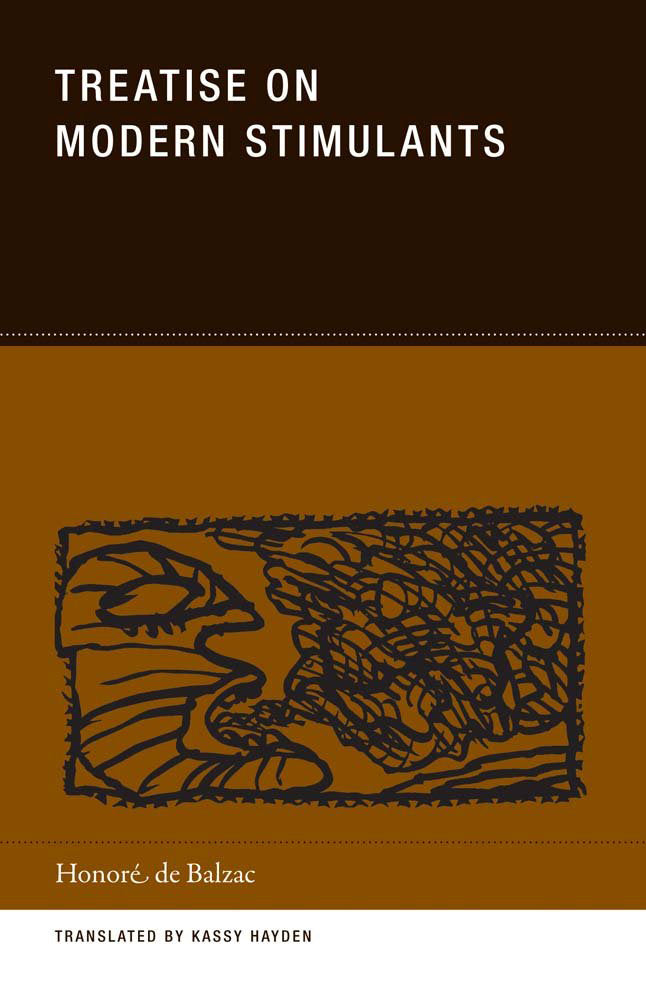Treatise on Modern Stimulants
Treatise on Modern Stimulants
Honoré de Balzac
Couldn't load pickup availability
Translated, with an introduction, by Kassy Hayden / Illustrations by Pierre Alechinsky / September 2014 / 4.5 x 7, 88 pp. / 978-1-939663-38-2
Honoré de Balzac’s Treatise on Modern Stimulants is a meditation on excess by a man who lived by means of excess—an author very conscious of the fact that his gargantuan body of work was driven by an intake of intellectual stimulants (his bouts of writing would typically require ten to fifteen cups a day of his preferred coffee) that would ultimately shorten his life. First published in French in 1839 as an appendix to Jean Anthelme Brillat-Savarin’s Physiology of Taste, this Treatise was at once Balzac’s effort at addressing what he perceived to be an oversight in that cornerstone of gastronomic literature, a chapter toward his never-completed body of analytic studies (alongside such essays as Treatise on Elegant Living) that were to form an overarching “pathology of social life,” as well as a meditation on the role pleasure and excess play in shaping society. If the science behind Balzac’s inquiry on the impact of five stimulants—tea, sugar, coffee, alcohol, and tobacco—on the human body is now outdated (“The future of the human race depends on mucus” is but one of the memorable statements to be found in this text), his thesis in which intellectual benefit requires a corollary in bodily and societal harm highlights a thread to be found throughout his work and his life.
Balzac here describes his “terrible and cruel method” for brewing a coffee that can help the artist and author find inspiration (not recommended for blonds of weak constitution), explains why tobacco can be credited with having brought peace to Germany, and describes his first experience of alcoholic intoxication (which required seventeen bottles of wine and two cigars). Beyond its braggadocio and whimsy, though, this treatise ultimately speaks to Balzac’s obsession with death and decline, and attempts to confront in capsule form the broader implications of dissipating one’s vital forces, one’s energies, one’s inspiration, and, ultimately, one’s life..
Honoré de Balzac (1799–1850), was a true monolith of French letters, one of the fathers of realism, and a great abuser of coffee. His Human Comedy ended up consisting of over one hundred interlinked stories and novels, and featured a cast of some two thousand characters. One of the earliest components of this enormous body of work was a never-completed four-part Pathology of Social Life. Balzac’s physiologies and nonfiction sociological studies read like the casebooks of a sociological Sherlock Holmes, and remain the least-known components to Balzac's sprawling Comedy.
“An unwitting revolutionary”—Victor Hugo
“[Balzac] groups a complete history of French society from which, even in economic details … I have learned more than from all the prefessional historians, economists, and statisticians of the period altogether”—Friedrich Engels
Press
“The Treatise is Balzacian in its great range and strong pronouncements. […] The accompanying apparatus—notes, Afterword, chronology, and bibliography—do make this a useful and informative volume (and it’s a beautiful Pierre Alechinsky-illustrated pocket-sized edition, too), with Hayden's supporting material a helpful complement to the text.”
—M. O. Orthofer, The Complete Review
“The Treatise on its own is a marvel of brash opinion (‘You know this, smokers!’), contemporary science, politics, and experimental memoir.”
—Melanie Rehak, Bookforum
“[T]his little pamphlet shows that Balzac was one of the first been-there-done-that types when it comes to at least three major modern vices: coffee, smoking, and booze. […] Kassy Hayden’s translation is verbose, snide, and perfect easy-going fun.”
—Martin Billheimer, Counterpunch
“This handsome, pocket-sized offering from Wakefield Press, featuring a beautiful set of illustrations by the Belgian artist Pierre Alechinsky, merits an afternoon’s quiet investigation.”
—André Naffis-Sahely, Times Literary Supplement


